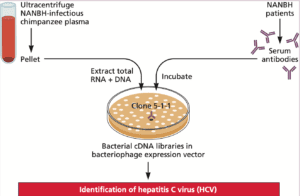

The 2020 Nobel Prize in Medicine has been awarded to Harvey Alter, Michael Houghton, and Charles Rice for their work leading to the discovery of hepatitis C virus. To me this prize makes a great deal of sense because each of the recipients produced key sequential discoveries, all of which were needed to find a new viral agent of hepatitis.
Transmissible liver disease has been known for thousands of years. One form was known to be transmitted by feces, and a viral etiology for this disease, subsequently called hepatitis A, was determined after WWII. The agent of a different form of hepatitis transmitted by blood and body fluids was identified in 1967 by Blumberg and colleagues and called hepatitis B virus. Blumberg received the 1976 Medicine Nobel Prize for this discovery.
Harvey Alter was studying hepatitis at the same time as Blumberg and observed that there were cases not caused by either hepatitis A or B virus. He showed that blood from these patients could transmit the disease to chimpanzees. By the mid-1980s studies of infected blood from patients with non-A, non-B (NANB) hepatitis showed the presence of small (less than 80 nm) enveloped particles, suggesting a viral etiology. However, the NANB agent could not be propagated in cell culture.
Identification of the agent of NANB was done by Michael Houghton, working at the Chiron Corporation. He and his colleagues produced a cDNA library from the plasma of an infected chimpanzee. The plasma had been first subjected to high speed centrifugation to enrich for virus particles. The cDNA library was inserted into a phage lambda expression vector designed to produced protein from cloned DNA (pictured; image credit). Plaques were then screened with serum from a chronic NANB patient. The idea was that antibodies to the virus in the serum would react with proteins produced in bacteria from the phage vector. One positive clone, called 5-1-1, was identified out of one million clones that were screened. Sequence analysis of the insert revealed the presence of a (+) strand RNA genome of a novel member of the Flaviviridae. This virus was subsequently named hepatitis C virus. One consequence of this work is that diagnostic reagents were then produced and revealed that many millions of people worldwide were infected with this virus.
Despite having cloned the viral genome, no one was able to recover infectious virus from cells transfected with cloned DNA or RNA transcripts.
Charles Rice and colleagues addressed this problem by producing multiple DNA clones of the viral genome from the serum of a patient with NANB hepatitis. After determining the nucleotide sequence of multiple DNA clones, a consensus genome was constructed that was thought to represent the correct sequence, including the authentic 5′- and 3′-termini. RNA transcripts of each of 10 different clones were inoculated into the liver of two chimpanzees, who subsequently developed hepatitis.
The work of these three groups led to the identification of hepatitis C virus. However, it was not until 2005 that the complete replication of hepatitis C virus was achieved in cells in culture. This work was done by Wakita and colleagues, and represented the last discovery needed to develop antiviral drugs to inhibit reproduction. Today patients treated with a mixture of two or three antiviral drugs can have their hepatitis C cured within months.

Last year I accidentally came to know that I have contracted Hepatitis B. I actually don’t know how or when I contracted it but I have it, I was so depressed to know about it, but WorldHerbsClinic HBV HERBAL FORMULA was a blessing for me, I am thankful to everyone here. After three months of using their HBV HERBAL FORMULA, my test result came out negative..Please don’t neglect this testimony, because is 100% real. Thanks.